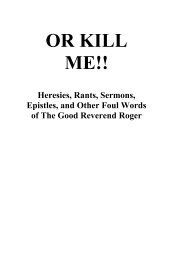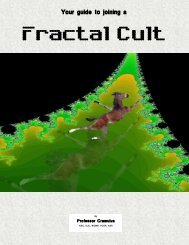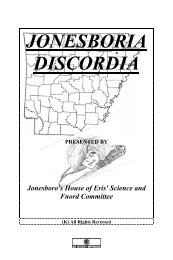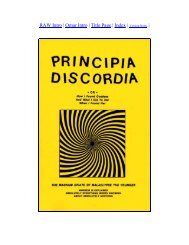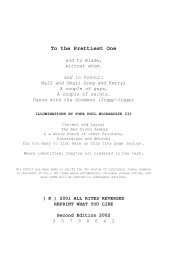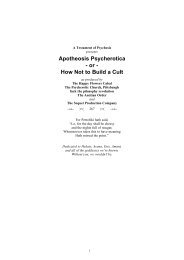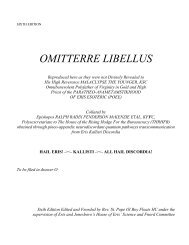Coincidance - Principia Discordia
Coincidance - Principia Discordia
Coincidance - Principia Discordia
Create successful ePaper yourself
Turn your PDF publications into a flip-book with our unique Google optimized e-Paper software.
6 COINCIDANCE<br />
also because Stephens had the same first name as Joyce (James) and had a<br />
last name which differed by only one letter from the first name of Stephen<br />
Dedalus, Joyce's self-caricature in A Portrait of the Artist as a Young Man and Ulysses.<br />
Finnegans Wake is in many ways an extension and enlargement of the<br />
forbidden and"unthinkable"areas of human experience first explored in Ulysses.<br />
It is more "difficult" than the earlier book, much more "obscene," more<br />
experimental in styles, much funnier, and contains many, many more<br />
synchronicities.<br />
As Ulysses was the anatomy of one day in Dublin, Finnegans Wake is the<br />
encyclopedia of one night in Dublin. Where Ulysses has a normal day-light<br />
protagonist, Leopold Bloom, who travels through real streets, Finnegans Wake<br />
has a multiple protagonist, abbreviated as in Joyce's notebooks; not a<br />
"character" in the normal sense, this system-function, , wanders<br />
through the labyrinths of alternative realities. In explicating this systemfunction,<br />
I shall try to indicate why Yositani Roshi once said, "There is<br />
nothing special about Enlightenment. You do it every night in your sleep.<br />
Zen is justa trick for doing it while awake."Finnegans Wake is another trick for<br />
doing it while awake.<br />
The "paranormal" aspect of the synchronicities we shall be studying can<br />
be "explained" in various ways, including the Fundamentalist Materialist's<br />
favorite non-explanation or pseudo-explanation, "mere coincidence." My<br />
own preference, as shall become more clear as we proceed, is along the lines<br />
of Yositani's identification of dream processes with those things we call<br />
"mystical" or "occult." As the psychiatrist Jan Ehrenwald wrote in New<br />
Dimensions of Deep Analysis, the so-called "paranormal" is very normal:<br />
We have seen time and again that despite their apparently capricious,<br />
haphazard nature ("paranormal" events) are governed by the same laws<br />
which apply to the dream, to the neurotic symptom and to unconscious<br />
processes in general.<br />
This was also the view of Freud in his famous essay "On the Uncanny"<br />
and of Jung in all his writings.<br />
Since a dream conventionally requires a dreamer, Joyce as early as 1923<br />
(one year into the writing of the book, which required 17 years) selected the<br />
name Earwicker for the waking ego of the protagonist. This is the point at<br />
which most Wake scholarship has gone wrong: since Earwicker is the<br />
waking ego, exegetes have thought Earwicker is the protagonist, but he is<br />
only one part of the protagonist. E or Ego or Earwicker is only part of the<br />
system-function , which is the total protagonist, as we shall see. But<br />
before investigating , let us look at E or Earwicker.<br />
Joyce reputedly found the name "Earwicker" on a tombstone in Sidlesham,



